Tesla Model S VS Porsche Cayman – Specs, Efficiency & Price Comparison
Which model is the better choice – the Tesla Model S or the Porsche Cayman? We compare performance (1020 HP vs 500 HP), boot capacity (793 L vs 184 L), efficiency (17.50 kWh vs 13 L), and of course, the price (94300 £ vs 136000 £).
Find out now which car fits your needs better!
The Tesla Model S (Hatchback) is powered by a Electric engine and comes with a Automatic transmission. In comparison, the Porsche Cayman (Coupe) features a Petrol engine and a Automatic gearbox.
When it comes to boot capacity, the Tesla Model S offers 793 L, while the Porsche Cayman provides 184 L – depending on what matters most to you. If you’re looking for more power, you’ll need to decide whether the 1020 HP of the Tesla Model S or the 500 HP of the Porsche Cayman suits your needs better.
There are also differences in efficiency: 17.50 kWh vs 13 L. In terms of price, the Tesla Model S starts at 94300 £, while the Porsche Cayman is available from 136000 £.
Compare all the key specs now and find out which model fits your lifestyle best!
Tesla Model S
The Model S continues to set the standard for luxury electric vehicles, seamlessly blending performance with cutting-edge technology. Its sleek design and spacious interior provide an unparalleled driving experience, making it an ideal choice for modern enthusiasts. With features that emphasize both safety and sustainability, the Model S showcases the future of automotive innovation.
details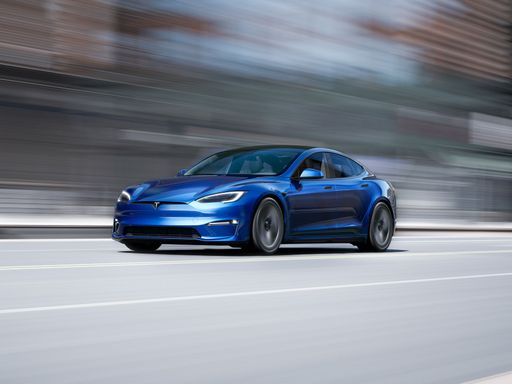 @ Tesla
@ Tesla
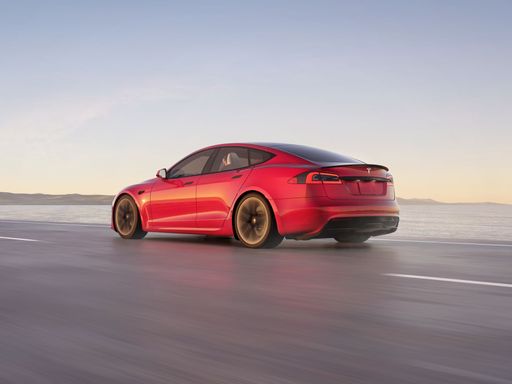 @ Tesla
@ Tesla
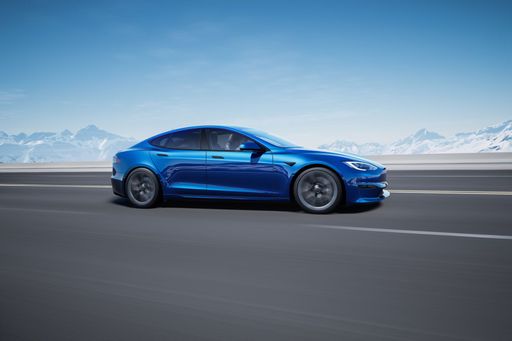 @ Tesla
@ Tesla
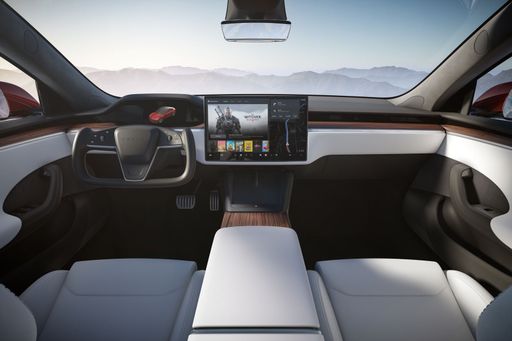 @ Tesla
@ Tesla
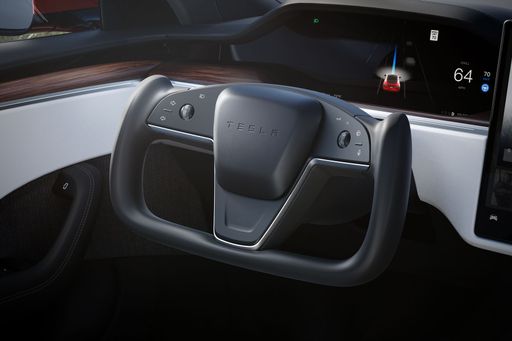 @ Tesla
@ Tesla
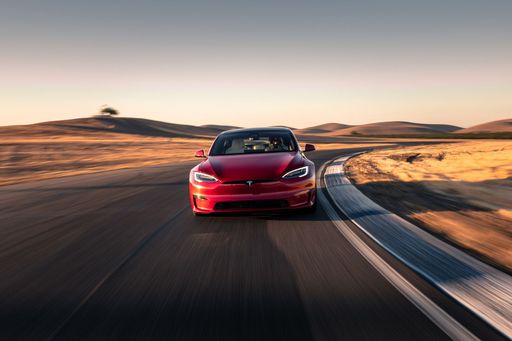 @ Tesla
@ Tesla
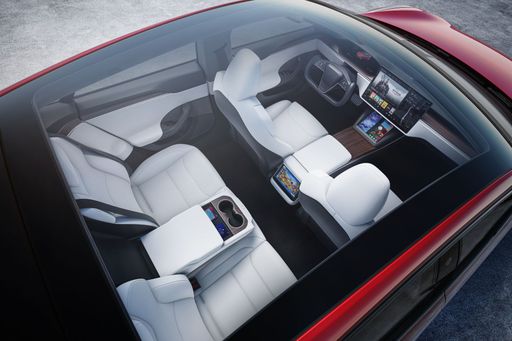 @ Tesla
@ Tesla
Porsche Cayman
The Porsche Cayman stands out as a quintessential sports car, blending sleek design with dynamic handling. Its mid-engine layout provides an excellent balance and sharp agility that driving enthusiasts crave. Inside, the Cayman offers a refined and driver-focused interior, ensuring that every journey is an exhilarating experience.
details

|
|
|
|
|
Costs and Consumption |
|
|---|---|
|
Price
94300 - 102800 £
|
Price
136000 £
|
|
Consumption L/100km
-
|
Consumption L/100km
13 L
|
|
Consumption kWh/100km
17.5 - 18.7 kWh
|
Consumption kWh/100km
-
|
|
Electric Range
600 - 634 km
|
Electric Range
-
|
|
Battery Capacity
-
|
Battery Capacity
-
|
|
co2
0 g/km
|
co2
295 g/km
|
|
Fuel tank capacity
-
|
Fuel tank capacity
54 L
|
Dimensions and Body |
|
|---|---|
|
Body Type
Hatchback
|
Body Type
Coupe
|
|
Seats
5
|
Seats
2
|
|
Doors
5
|
Doors
2
|
|
Curb weight
2170 - 2265 kg
|
Curb weight
1490 kg
|
|
Trunk capacity
793 L
|
Trunk capacity
184 L
|
|
Length
5021 mm
|
Length
4456 mm
|
|
Width
1987 mm
|
Width
1822 mm
|
|
Height
1431 mm
|
Height
1267 mm
|
|
Payload
364 kg
|
Payload
281 kg
|
Engine and Performance |
|
|---|---|
|
Engine Type
Electric
|
Engine Type
Petrol
|
|
Transmission
Automatic
|
Transmission
Automatic
|
|
Transmission Detail
-
|
Transmission Detail
Automat. Schaltgetriebe (Doppelkupplung)
|
|
Drive Type
All-Wheel Drive
|
Drive Type
Rear-Wheel Drive
|
|
Power HP
670 - 1020 HP
|
Power HP
500 HP
|
|
Acceleration 0-100km/h
2.1 - 3.2 s
|
Acceleration 0-100km/h
3.40 s
|
|
Max Speed
250 - 300 km/h
|
Max Speed
315 km/h
|
|
Torque
-
|
Torque
450 Nm
|
|
Number of Cylinders
-
|
Number of Cylinders
6
|
|
Power kW
493 - 750 kW
|
Power kW
368 kW
|
|
Engine capacity
-
|
Engine capacity
3996 cm3
|
General |
|
|---|---|
|
Model Year
2022 - 2023
|
Model Year
2021
|
|
CO2 Efficiency Class
A
|
CO2 Efficiency Class
G
|
|
Brand
Tesla
|
Brand
Porsche
|
Tesla Model S
The Revolutionary Tesla Model S: The Pinnacle of Electric Vehicles
The Tesla Model S has reshaped the landscape of electric vehicles since its introduction, combining luxury, performance, and cutting-edge technology into a single package. As we delve into the technical aspects and innovations of this remarkable car, it becomes clear why it stands out in an increasingly crowded market.
Performance That Redefines Speed
The latest iterations of the Tesla Model S offer exhilarating performance, with two distinct variants: the standard Model S and the thunderous Model S Plaid. The standard Model S is powered by a robust electric motor producing 670 horsepower, allowing for a jaw-dropping 0-100 km/h time of just 3.2 seconds. For those who demand even more power, the Model S Plaid boasts a staggering 1,020 horsepower, achieving the same speed in an incredible 2.1 seconds.
Both models feature all-wheel drive and a sophisticated reduction gearbox that ensures optimal traction and efficiency, making every drive an exhilarating experience. The Model S’s top speed reaches up to 250 km/h for the standard version, while the Plaid variant impressively escalates to 300 km/h.
Range and Efficiency: Driven by Innovation
One of the most significant concerns for electric vehicle owners is range, and Tesla has addressed this head-on with the Model S. The standard Model S boasts an impressive electric range of 634 km on a single charge, demonstrating the extraordinary efficiency of Tesla’s engineering. The Plaid model, while slightly less at 600 km, still puts many competitors to shame.
The energy consumption rates for both models are equally commendable, with the standard version achieving a remarkable 17.5 kWh/100 km and the Plaid version at 18.7 kWh/100 km. This high efficiency is not only good for the environment but also for the owner's wallet, providing longer driving ranges between charges.
Innovative Technology and Features
The Tesla Model S is loaded with high-tech features designed to enhance the driving experience. The centerpiece of this technological innovation is its large touchscreen interface. This 17-inch display controls virtually every aspect of the vehicle, from navigation to climate control, creating a streamlined and modern cabin environment.
Additionally, the Model S includes advanced autopilot features that allow for semi-autonomous driving capabilities, redefining what drivers can expect from their vehicles. These innovations highlight Tesla's commitment to safety and convenience, making the Model S not just a car but an advanced tech-laden machine.
Luxury Meets Practicality
The Model S does not compromise on luxury. With a spacious interior accommodating five passengers and a premium finish, it offers comfort that rivals luxury sedans. The trunk capacity of 793 liters ensures ample space for luggage or other essentials, making it a practical choice for families or long road trips.
Moreover, its sleek hatchback design merges elegance with functionality, while the eco-conscious design features a remarkable CO2 efficiency class of A, underscoring Tesla’s commitment to sustainability.
Conclusion: The Future Is Electric
The Tesla Model S exemplifies the future of automotive technology, merging unparalleled performance, innovative features, and luxury. As electric vehicles continue to gain traction in the global market, the Model S stands as a benchmark, illustrating what is possible when cutting-edge technology meets passionate engineering. As drivers demand more from their vehicles, the Model S proves itself not just as a car, but as a movement toward a sustainable and exhilarating future.
Porsche Cayman
The Porsche Cayman: A Masterclass in Precision Engineering
For decades, Porsche has been synonymous with precision, power, and unparalleled driving experience. The Porsche Cayman, particularly the newest iteration like the 718 Cayman GT4 RS, continues this legacy with a suite of cutting-edge technical features and exhilarating performance capabilities. Nestled in the sports car segment, this coupe has been engineered to provide an almost symbiotic relationship between car and driver.
Performance that Blazes a New Trail
The heart of the Cayman GT4 RS is a robust 4.0-liter naturally aspirated flat-six engine, pushing out an astounding 500 horsepower. This engine provides a visceral connection to the road, combined with a curiously addictive exhaust note that Porsche enthusiasts have come to love. With 450 Nm of torque, the acceleration feels unyielding, propelling the car from 0 to 100 km/h in a mere 3.4 seconds. Coupled with a PDK dual-clutch automatic transmission, each gear change feels precise and instantaneous, making it an exhilarating drive on both road and track.
Innovative Design Meets Functionality
The Porsche Cayman has always showcased a balance of aesthetic elegance and aerodynamic functionality. With a length of 4456 mm, width of 1822 mm, and a height of 1267 mm, the dimensions are tightly packed for optimal stability and agility. The coupe's 1490 kg curb weight contributes to its nimbleness, while the rear-wheel-drive configuration ensures a pure sports-car feel.
Efficiency Coupled with Performance
While performance is at the core of the Porsche ethos, efficiency hasn't been compromised. The Cayman GT4 RS has a fuel consumption rate of 13 L/100 km, striking an impressive balance between power and sustainability, although it maintains a CO2 efficiency class of G, indicative of its performance-oriented design.
Details that Make a Difference
Inside the cabin, the Cayman is fitted to perfection with a focus on the driver-centric experience. Despite its sporty DNA, it doesn't skimp on comfort—there's ample seating for two alongside a sizable trunk capacity of 184 liters, enhancing its practicality for weekend getaways.
Additionally, the car boasts a CO2 emission of 295 g/km and supports a payload of 281 kg, underscoring its utility without detracting from its core focus on high performance.
The Ultimate Driving Machine?
With a top speed of 315 km/h, the Cayman GT4 RS lives up to its billing as a track-bred sports car. The precision engineering, combined with innovative technological integrations, sets it apart from contemporaries in its class. While the sleek exterior exudes luxury, it's the engineering beneath that makes the Cayman an acme of what a modern sports coupe can achieve.
In the Porsche Cayman, enthusiasts meet a machine so finely tuned and so divinely balanced that it stands as a testament to the relentless pursuit of perfection—a masterpiece of modern automotive engineering.
The prices and data displayed are estimates based on German list prices and may vary by country. This information is not legally binding.
